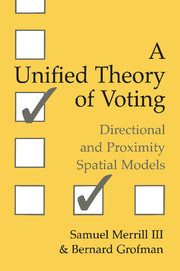Postscript
Published online by Cambridge University Press: 04 December 2009
Summary
In a democracy it is frequently necessary to enter the polling booth, holding one's nose.
Bernard Levin, Quote, Unquote (1989: 88)The aim of this book has been to offer a unified theory of voter choice. At the outset, we asked two major questions: (1) How do voters translate information about the issue positions advocated by the candidates into voting decisions based on the voters' preferences for outcomes? (2) What are the implications of such voting behavior for the strategy of candidates and parties? For example, how do candidates and parties adopt their issue positions in the light of what they come to know/believe about voter decision rules and voter issue preferences? Under what conditions will there be candidate/party equilibria with respect to issue positions, i.e., sets of platforms that, once adopted, will remain more or less the same because no candidate (or party) believes that she can improve her vote share by shifting her proposed issue positions as long as the other candidates/parties do not change theirs?
These questions have been at the heart of a vast body of research stemming from the seminal work of Anthony Downs (1957). No work of scholarship stands alone; we have built on the work of many others. As we see it, the heart of our own contribution to earlier work seeking to answer these two questions is fourfold.
First, we have provided an empirically practical way of integrating the Downsian perspective on issue proximity with later work – emphasizing directionality of choice – by offering a unified model of voter choice.
Information
- Type
- Chapter
- Information
- A Unified Theory of VotingDirectional and Proximity Spatial Models, pp. 164 - 169Publisher: Cambridge University PressPrint publication year: 1999
